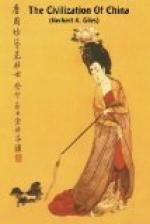The grandeur of Kublai Khan’s reign may be gathered from the pages of Marco Polo, in which, too, allusion is made to Bayan, the skilful general to whom so much of the military success of the Mongols was due. Korea, Burma, and Annam became dependencies of China, and continued to send tribute as such even up to quite modern times. Hardly so successful was Kublai Khan’s huge naval expedition against Japan, which, in point of number of ships and men, the insular character of the enemy’s country, the chastisement intended, and the total loss of the fleet in a storm, aided by the stubborn resistance offered by the Japanese themselves—suggests a very obvious comparison with the object and fate of the Spanish Armada.
Among the more peaceful developments of Mongol rule at this epoch may be mentioned the introduction of a written character for the Mongol language. It was the work of a Tibetan priest, named Baschpa, and was based upon the written language of a nation known as the Ouigours (akin to the Turks), which had in turn been based upon Syraic, and is written in vertical lines connected by ligatures. Similarly, until 1599 there was no written Manchu language; a script, based upon the Mongol, was then devised, also in vertical lines or columns like Chinese, but read from left to right.
Under Kublai Khan the calendar was revised, and the Imperial Academy was opened; the Yellow River was explored to its source, and bank-notes were made current. The Emperor himself was an ardent Buddhist, but he took care that proper honours were paid to Confucius; on the other hand, he issued orders that all Taoist literature of the baser kind was to be destroyed. Behind all this there was extortionate taxation, a form of oppression the Chinese have never learned to tolerate, and discontent led to disorder. Kublai’s grandson was for a time an honest ruler and tried to stem the tide, but by 1368 the mandate of the Mongols was exhausted. They were an alien race, and the Chinese were glad to get rid of them.




